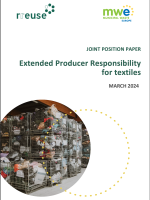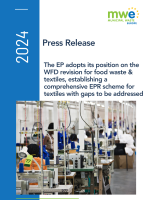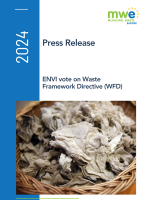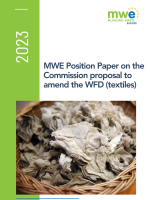Position Paper on Textiles
Over the last decades, the textile industry has placed an increasing quantity of more and more complex textiles with increasing percentages of manmade polymer content on the market without enough attention to the possible consequences. According to the European Environment Agency, "among all consumption domains in the EU, consumption of clothing, footwear and household textiles is the fourth highest pressure category for primary raw material use and for water use, and the fifth highest for greenhouse gas emissions"1. Moreover, when textiles become waste, this has a further significant impact not only on the environment but also on European and third countries' societies.
In this light, MWE welcomes the European Commission's proposals on textiles set out in the Circular Economy Action Plan 2.02. MWE members, representatives of the public responsibility for waste collection in EU Member States, are also highly aware of the target imposed by the Waste Framework Directive for textiles: all EU countries are mandated to set up separate collection of textiles by 1 January 2025. However, we underline that setting a separate collection target is not enough and further research and policy developments are urgently need.
With a view to creating a circular economy for textiles, MWE identifies a number of needs. We call on policymakers to carefully consider the points hereunder, in the upcoming EU Strategy for Textiles, in the Sustainable Products Policy Framework and in any further EU strategies and legislation related to textiles and textile waste:
1. Definition of separate collection for textiles.
It is necessary to establish a better definition, as the term 'textiles'3 is rather broad and covers a wide range of products and materials from yarns, fibres or fabrics to household textiles (carpets, towels, bed-linen...), clothing, technical equipment (COVID-19 masks, special workwear...) and agricultural textiles for crop protection, just to mention a few.
2. Ecodesign measures and high-quality textiles.
Textiles must be included in the Sustainable Products Policy Framework and in particular in the Ecodesign Directive. Boosting ecodesign measures is necessary in order to eliminate deficiencies in quality, durability, reusability and reparability of textile products in line with the waste hierarchy. The increasing amount of low quality textile products4 and their high complexity is hindering reuse and make the recycling process more complex. MWE would welcome measures which address the recyclability of textiles.
3. Reuse, repair and secondary raw materials markets.
Currently the global market for reused and recycled textiles4 is underdeveloped. If this is not addressed simultaneously to the increase in separate collection and treatment, the same difficulties and challenges associated with access to market for recycled plastics will occur; lack of price competitivity resulting in stockpiles which often have to ultimately be incinerated or co-incinerated. After the process of separate collection, sorting and recycling, this would not be the most economically viable solution.
To ensure that this is not the ultimate outcome of efforts to create a circular economy for textiles, MWE would advise the encouragement of widespread repair and reuse business models, promotion of reuse, second-hand shopping and customization as well as encouraging investment in textile recycling plants that can create new yarns and other new products from waste textiles.
It follows that, alongside the 2025 target, it is of paramount importance to establish EU binding targets for textile waste prevention, reduction, reuse, repair, remanufacturing, recycling and the elimination of landfilling and incineration of textiles and to establish minimum recycled content for new textiles placed on the EU market.
4. Export of used textiles and textile waste from the EU to third countries.
As a result of increasing quantities of textile waste which cannot be treated or absorbed by the EU, Member States are increasingly exporting outside the EU and world markets are also becoming saturated. Indeed, as already occurred with plastic packaging waste, some importing countries are imposing restrictions4. Therefore, in order to reduce EU dependency on third countries and to keep the valuable raw materials from textiles within the EU market, the EU must reverse this tendency by developing its own market for second-hand clothing and used textiles.
5. Transparency and traceability.
MWE identifies a need for research on how charity organizations and retail companies collect, sort and trade second-hand garments since we identify an overall lack of transparency in this respect. Moreover, MWE identifies a lack of transparency with regard to production process and labour conditions as well as environmental, social and health impacts, such as durability, recyclability, chemicals or carbon footprint. Hence, MWE calls the European Commission to take measures to enhance transparency throughout the value chain and the life cycle of textiles, taking into consideration environmental, social and health impacts from production to the treatment of textile waste.
6. Extended Producer Responsibility (EPR) for textiles.
The upcoming EU Strategy on Textiles must include the development of an EPR scheme for textiles, establishing the contribution from retailers/brands to at least ecodesign, circular business models, take-back schemes, investments in recycling technology, ban on the deliberate destruction of unsold and returned goods, commitment to the use of high quality textiles products. This should also consider the international dimension of the fashion industry's value chain and impose the same environmental and social responsibility on imports of finished products into the EU as EU production is subject to. The Carbon Border Adjustment Mechanism will be instrumental here. Further to this, the creation of EPR schemes must not replace municipal and non-profit collection structures, but should support them through financing mechanisms, as well as back them with product design and recycling specifications.
7. Sharing knowledge on available technology for treatment.
In particular, for proper sorting and recycling of post-consumer textiles. The European Commission should facilitate and promote the exchange of best practice and information on the most efficient current available technology across the Member States and stakeholders since MWE identifies that there is a general lack of knowledge in this area among their members. To do that, the Commission may share information through a dedicated website or platform, just to mention a suggestion. Moreover, the European Commission should take the most advantage of its tools, such as the TAIEX EIR PEER-TO-PEER and INTERREG Europe projects in order to enhance this knowhow and push for a true circular economy for textiles in the EU. Additionally, the European Commission should promote cooperation between different stakeholders (retailers, fashion industry, municipalities/local authorities, charities and social enterprises) to boost research, innovation and shared knowledge.
8. Hazardous chemicals and microplastics.
Although these issues are not directly within MWE's scope, we also welcome measures to prevent the release of microplastics and toxic chemicals into the environment and so prevent further impacts on health. These measures must be included in the entire life cycle of textiles, in particular in the ecodesign measures and post-consumer textile treatment.
In this context, special attention must be paid to water protection. For this reason, MWE supports the measures announced in the roadmap for more sustainable handling of chemicals. The Circular Economy Action Plan foresees the restriction of the intentional addition of microplastics to products, and the development of measures to reduce the unintentional release of microplastics, on labelling, standardisation, certification and regulatory measures. In addition, methods for measuring unintentionally released microplastics are to be further developed and harmonised. These projects must also be taken up in the new textile strategy. Only in this way can an early reduction of microplastics at source and the further input of microplastics from textiles into the environment and water bodies be avoided.
9. Consumer behaviour, information and labelling.
Textiles, especially clothing, are associated with social, cultural and even psychological factors which significantly influence consumer behaviour. Social media as well as the textile and particularly the fashion industry play a key role in this. For this reason, MWE calls for 'fast fashion' and other business models including advertising that encourage quick 'buyuse-discard' behaviour to be explicitly tackled in the EU Strategy for Textiles. This should include the control of access to EU social media of non-EU producers who are using 'fast fashion' tactics to sell to the EU market. On the other hand, consumers should have access to better information on the products they purchase. For this reason, MWE calls for a mandatory labelling scheme that requires the labels for the EU market include not only the origin of the product, types of fibres and washing instructions but also information on the recycled content, correct disposal method (including encouragement to give away for reuse/second hand) and recyclability.
10. EU-wide ban on deliberate destruction or landfill of unsold and return textiles.
Textile waste recyclers in Germany report that fashion sellers do not sell returned goods which automatically become waste and are sent to the recyclers still in their packaging. This entails a huge waste of energy and natural resources that could be reused or recycled but the larger quantities still end up in incineration or landfill. Ultimately the practice is wasteful and should be stopped.
11. COVID-19 disposable masks.
In the exceptional circumstances we are living through today, the huge amount of disposable face masks has raised a new problem. These are usually disposed of in the residual bin are often flushed down toilets ending up in the waste water or are littered in the environment. MWE calls on Member States and the Commission to set up campaigns to promote the use of reusable face masks and welcomes innovative initiatives on recycling provided that they are embedded in the circular economy model. Very importantly, it is necessary to define the waste stream for them, as it seems not to be clear at the moment if they should go into the plastic waste stream or the textiles waste stream.
In conclusion we would like to underline the importance of the points we raise to the successful creation of a circular economy for textiles. Separate Collection alone, implemented by 2025, will not achieve this. To retain the value of the textiles and thereby prevent losses which is the aim of a circular economy, the value chain needs both financial and waste treatment aspects to be transparently organised and fine-tuned. We identify the need for suitable investments, strategically allocated in order to successfully address the above; in particular investment in research and development, in the establishment of circular business models and in facilities with the requisite technology to transform post-consumer textiles into new materials and products.




